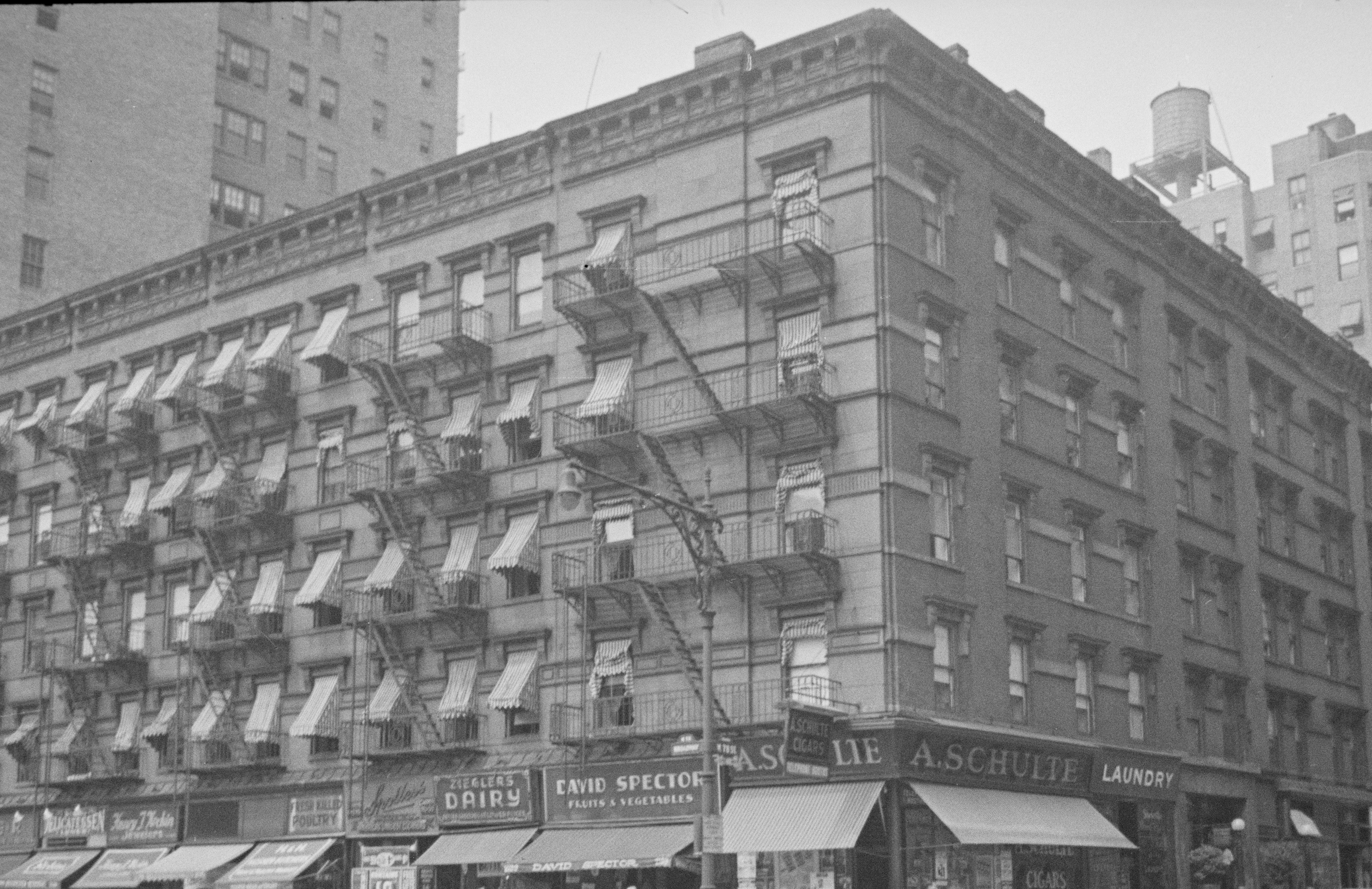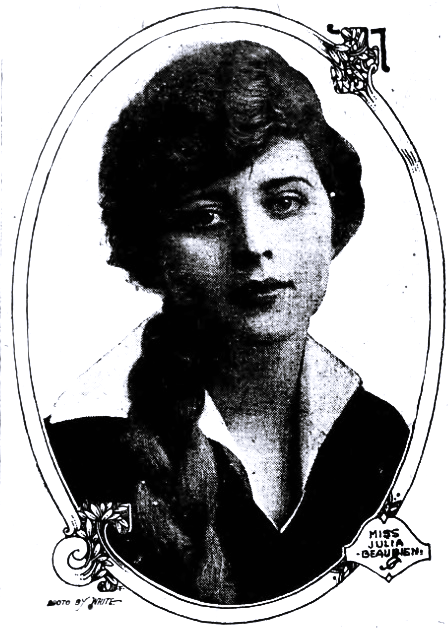
The Curlew
by Tom Miller
On May 23, 1991, the Record & Guide reported that Morris Steinhardt and his wife, Josephine, had sold the southwest corner of the Boulevard and 78th Street to William Forster and James Livingston. The vacant plot was nearly square, running 100 feet along the avenue (renamed Broadway around 1900) and 102 feet on the side street. The developers hired architect Gilbert A. Schellenger to design six flat (or apartment) buildings on the site, five facing Broadway and one on West 78th Street.
Schellenger designed the brownstone-faced buildings in the neo-Grec style, the geometric lines of which rebelled against the scrolled, foliate decorations of the earlier Italianate. A store space, located on the corner, was included in the design and provided additional income for Forster and Livingston. It became home to Emil Gennerich’s grocery store, which would remain in the space until 1926.
The buildings filled with middle- and upper-middle-class tenants, like inventor Isaac Ludlow. He, like so many men at the turn of the last century, was fascinated with the possibility of human flight. He had a brief spark of success on August 4, 1905, when he launched his fourth manned airship. The Brooklyn Daily Star reported, “First there was a procession which marched from Mr. Ludlow’s home, 250 West Seventy-Eighth street, to the riverside, carrying the airship, its great wings, thirty feet long by fifteen wide, filling most of the street and causing even the oldest of truck horses to wiggle their ears.”
Once at the river’s edge, the glider and its pilot, Charles Hamilton, were pulled aloft by an automobile. The Daily Star said, “As the automobile moved along the river bank scarcely faster than a man can walk, the flying machine rose gracefully into the air, apparently unhampered by Hamilton’s weight. It soared a hundred feet, the length of the rope, and then floated easily while Hamilton smiled and waved his hand at the crowd.” And then the automobile ran out of roadway and had to stop.
The Sun reported that the “Ohs” and “Ahs” of the crowd of 2,000 died away as “down came the whole concern.”
“What happened was just what happens when a small boy who has tried to get his kite up on a calm day stops running,” said the article. The Sun reported that the “Ohs” and “Ahs” of the crowd of 2,000 died away as “down came the whole concern.” Hamilton emerged from the wreckage unharmed. “There was plenty of cheering now,” said The Daily Star, “but it was interrupted in the middle by a wild howling which came from the disabled airship.” It turned out that Hamilton had landed the ship on a small boy “who was nearly freighted to death, but otherwise uninjured.” Despite the condition of his crumpled invention, Ludlow deemed his trial “a perfect success.” He told a reporter, “All I need now is motor power on board ship and then the problem is solved.”
In 1910 the new owners, the Seventy-Eighth Street and Broadway Co., hired the architectural firm of Schwartz & Gross to make the equivalent of $2 million today in renovations to the property. Additional storefronts were installed along Broadway, the buildings were joined internally, and a single residential entrance was established at 250 West 78th Street. The remodeled building, completed in 1911, was named The Curlew, possibly a nod to William Butler Yeat’s popular 1896 poem “He Reproves the Curlew.”
An advertisement in The New York Times on September 3, 1911, called The Curlew “A modern apartment house, exceptionally well located. Suitable to those who desire a small housekeeping apartment in a high class building.” The apartments had either three or four rooms plus a bath and ranged from $45 to $65 rent or about $1,450 per month for the more expensive by today’s terms.
The varied tenant list included Dr. Timothy Delaney, a veterinarian; physician Edward L. Finch; and Katherine Boyle, a talent agent who managed entertainers like Gay Zenola MacLaren, “America’s Most Original Entertainer,” who single-handedly staged plays like Little Women and Rebecca of Sunnybrook Farm, playing all the roles. Another tenant involved in the entertainment field was actor Arthur Stanford, who first appeared on the stage in 1896 as Tyrrell in Richard III. He had recently appeared with famous actor Joseph Jefferson in The Rivals.
Diana gave him the boxes, “but he did not take them to the Watriss home, nor did he belong there,” reported the New York Herald. “The police are trying to discover his identity and also what became of the dresses and laces.” The value of the dresses was $2,500 and the laces were worth $700—a total loss of more than $32,000 in today’s money.
Actresses Julia Beaubien and Vivian Rogers lived in apartments in The Curlew at the time. Beaubien cleverly pawned her valuable jewelry every summer when she was gone from the city and retrieved it in the fall. The practice prevented the possibility of thefts in her frequent absences during the summer months. The seemingly fool-proof plan fell apart in August 1915.
Like most residents of The Curlew, she had a maid. On August 5, while Julia was “on an outing” at Far Rockaway, Le Vernie A. Davis appeared at her apartment. The New York Press reported that he “introduced himself as ‘Julia’s big kid brother’ to her negro maid and proceeded to make himself at home.” When Julia returned shortly after he left, she discovered the pawn ticket for a $1,000 diamond ring was missing.
Julia had known Davis, who was a cigarette salesman, for some time. She informed detectives and set up a sting. Giving no hint that she suspected him in the theft, she invited Davis to meet her at the upscale Café des Beaux-Arts on the evening of August 27. Sitting at the table with her were two plainclothes detectives. The Sun reported, “At a late hour a smiling, well-dressed young man entered, but when he saw her his expression changed and he tried to retreat.” He did not get far. He was held on $2,000 bail awaiting trial.
Incensed, she demanded he return her money, and he refused.
Another actress living in The Curlew to be victimized by a man was Helen Gill in 1921. She was approached by Sherman S. Keelberg about appearing in the film version of The Green Jade. He told her he had been offered “considerable sums” by other motion picture producers for the rights, but he felt the film would be more profitable if he produced it himself. The problem was that he needed financial backing.
He convinced Helen to invest in the film, until the various amounts she turned over to him amounted to over $7,000. And then she discovered that he did not own the rights to the play. Incensed, she demanded he return her money, and he refused. So, on May 18, 1921, she had him arrested on charges of grand larceny.
By the post-Depression years, the tenants of The Curlew had become increasingly middle class. The days of summer homes and maids were now gone. Among the tenants in the mid-1940’s was Irving Segelman, who shared an apartment with his brother, Paul.
On Labor Day 1946, three bandits pulled off what The Daily Argus called “the spectacular, armed robbery in the home of Nathan Tanzer” in Yonkers. The family told police that one man had forced his way into the house and held sisters Ruth and Ethel Tanzer at gunpoint while his accomplices searched the house. They went so far as to rip out the knotty pine boards of the recreation room and den looking for hidden valuables. They escaped with $5,000 in jewelry and $2,800 in cash.
More than a year later, on November 23, 1947, Ruth Tanzer viewed a lineup of 20 prisoners in the county jail. She “without hesitation” picked out Irving Segelman as the burglar who had held the gun to her head.
Today the brownstone façade has been inexplicitly painted brown—the color of brownstone. The shop fronts and the residential entrance have been unsympathetically modernized. Yet despite the architectural affronts, The Curlew retains much of its 1892 integrity.
Tom Miller is a social historian and blogger at daytoninmanhattan.blogspot.com
Building Database
Keep Exploring
Be a part of history!
Think Local First to support the businesses at 250 West 78th Street aka 2191-2199 Broadway:
Meet Russell Gellis!



